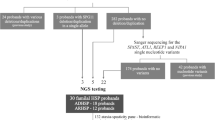Abstract
Hereditary spastic paraplegia (HSP) type 15 is an autosomal recessive (AR) form of complicated HSP mainly characterized by slowly progressive spastic paraplegia, mental retardation, intellectual deterioration, maculopathy, distal amyotrophy, and mild cerebellar signs that has been associated with the Kjellin syndrome. The locus for this form of HSP, designated SPG15, was mapped to an interval of 19 cM on chromosome 14q22–q24 in two Irish families. We performed a clinical-genetic study of this form of HSP on 147 individuals (64 of whom were affected) from 20 families with AR-HSP. A genome-wide scan was performed in three large consanguineous families of Arab origin after exclusion of linkage to several known loci for AR-HSP (SPG5, SPG7, SPG21, SPG24, SPG28, and SPG30). The 17 other AR-HSP families were tested for linkage to the SPG15 locus. Only the three large consanguineous families showed evidence of linkage to the SPG15 locus (2.4 > Z max > 4.3). Recombinations in these families reduced the candidate region from ~16 to ~5 Mbases. Among the ~50 genes assigned to this locus, two were good candidates by their functions (GPHN and SLC8A3), but their coding exons and untranslated regions (UTRs) were excluded by direct sequencing. Patients had spastic paraplegia associated with cognitive impairment, mild cerebellar signs, and axonal neuropathy, as well as a thin corpus callosum in one family. The ages at onset ranged from 10 to 19 years. Our study highlights the phenotypic heterogeneity of SPG15 in which mental retardation or cognitive deterioration, but not all other signs of Kjellin syndrome, are associated with HSP and significantly reduces the SPG15 locus.


Similar content being viewed by others
References
Harding AE (1983) Classification of the hereditary ataxias and paraplegias. Lancet 1:1151–1155
Fink JK (2003) Advances in the hereditary spastic paraplegias. Exp Neurol 184:S106–S110
Fink JK (2006) Hereditary spastic paraplegia. Curr Neurol Neurosci Rep 6:65–76
Kjellin K (1959) Familial spastic paraplegia with amyotrophy, oligophrenia, and central retinal degeneration. Arch Neurol 1:133–140
Hughes CA, Byrne PC, Webb S, McMonagle P, Patterson V, Hutchinson M, Parfrey NA (2001) SPG15, a new locus for autosomal recessive complicated HSP on chromosome 14q. Neurology 56:1230–1233
Elleuch N, Depienne C, Benomar A, Hernandez AM, Ferrer X, Fontaine B, Grid D, Tallaksen CM, Zemmouri R, Stevanin G, Durr A, Brice A (2006) Mutation analysis of the paraplegin gene (SPG7) in patients with hereditary spastic paraplegia. Neurology 66:654–659
Lossos A, Stevanin G, Meiner V, Argov Z, Bouslam N, Newman JP, Gomori JM, Klebe S, Lerer I, Elleuch N, Silverstein S, Durr A, Abramsky O, Ben-Nariah Z, Brice A (2006) Hereditary spastic paraplegia with thin corpus callosum: reduction of the SPG11 interval and evidence for further genetic heterogeneity. Arch Neurol 63:756–760
Gudbjartsson DF, Jonasson K, Frigge ML, Kong A (2000) Allegro, a new computer program for multipoint linkage analysis. Nat Genet 25:12–13
Abecasis GR, Cherny SS, Cookson WO, Cardon LR (2002) Merlin–rapid analysis of dense genetic maps using sparse gene flow trees. Nat Genet 30:97–101
Cottingham RW, Idury RM, Schaffer AA (1993) Faster sequential genetic linkage computations. Am J Hum Genet 53:252–263
Webb S, Patterson V, Hutchinson M (1997) Two families with autosomal recessive spastic paraplegia, pigmented maculopathy, and dementia. J Neurol Neurosurg Psychiatry 63:628–632
Stevanin G, Santorelli F, Azzedine H, Coutinho P, Chomilier J, Denora PS, Martin E, Ouvrard-Hernandez AM, Tessa A, Bouslam N, Lossos A, Charles P, Loureiro JL, Elleuch N, Confavreux C, Cruz VT, Ruberg M, Leguern E, Grid D, Tazir M, Fontaine B, Filla A, Bertini E, Durr A, Brice A (2007) Mutations in the SPG11 gene, encoding spatacsin, are a major cause of spastic paraplegia with thin corpus callosum. Nature Genet 39:366–372
Acknowledgments
We thank Drs S Belarbi, A Bouhouche, P Coutinho, D Grid, A Megarbane, C Mhiri, M Salih and P Vondracek for referring patients, Nawal Benammar, Elodie Denis, Lydia Guennec and Dr. S Forlani for their help as well as Dr M Ruberg for the critical reading of the manuscript. This work was supported by the Verum Foundation (to A Brice), the Groupement d’Intérêt Scientifique (to GS), the French National Agency for Research (to AD) and the Hadassah France Fund for studies in Hereditary Spastic Paraplegia (to AL). NE and SK were the recipients of fellowships from the Verum Foundation. NE and NB received financial helps from the Association Connaître les Syndromes Cérébelleux and the Association Française de l'ataxie de Frieidreich, respectively.
Author information
Authors and Affiliations
Corresponding author
Additional information
Elleuch and Bouslam are co-first authors.
Rights and permissions
About this article
Cite this article
Elleuch, N., Bouslam, N., Hanein, S. et al. Refinement of the SPG15 candidate interval and phenotypic heterogeneity in three large Arab families. Neurogenetics 8, 307–315 (2007). https://doi.org/10.1007/s10048-007-0097-x
Received:
Accepted:
Published:
Issue Date:
DOI: https://doi.org/10.1007/s10048-007-0097-x




